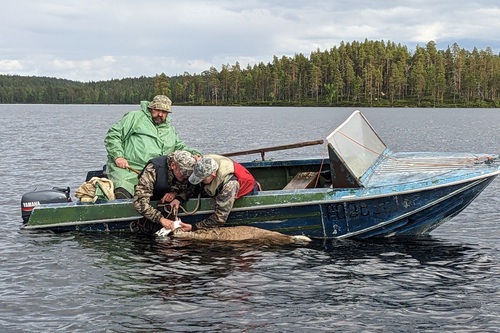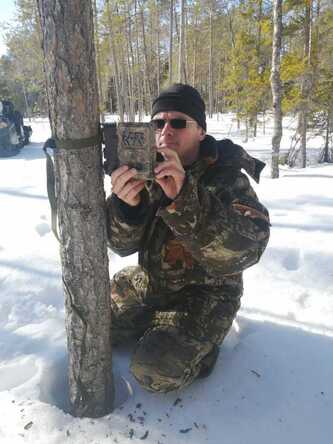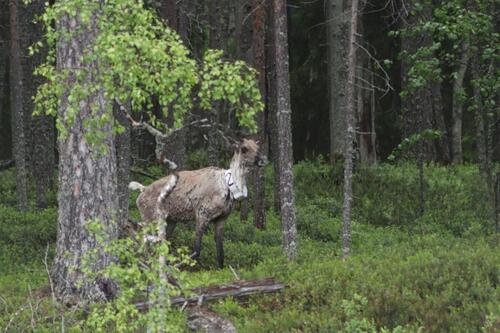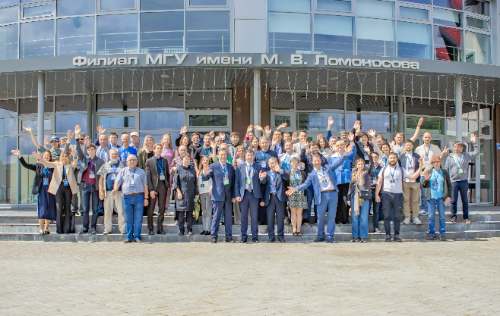
As part of the research project, scientists safely captured and GPS-collared three animals last summer.
– Through the collars, we get detailed information on animal movements, we can identify their preferences and the impact of various factors, such as forestry, on how they use space. How do the vast logged expanses restrain their movement? The observations will help us understand whether the reindeer use these territories or whether they become completely unsuitable for them, which naturally affects the well-being of the subpopulations, - explained Danila Panchenko, the leader of the research, Senior Researcher at the Institute of Biology KarRC RAS.
The project is financially supported by Severstal Company, which includes Karelsky Okatysh JSC as one of its divisions. The studies are conducted within the Kostomuksha Nature Reserve and Kalevala National Park and in their adjacent areas. The work gets full support from the Kostomuksha Nature Reserve.
Not only satellite collars, but also camera traps were purchased within the project. They help scientists obtain information on the age structure of the subpopulation, the number of calves, females and males. According to Danila Panchenko, the size is now maintained at the level of previous years: about 200 animals move on the Russian side. The total number of forest reindeer in Karelia is not more than two thousand animals. Special attention is required to preserve them in the region. Scientists warn that the population is under severe pressure from humans: this includes poaching, habitat reduction, migration barriers associated with economic activities, and tourism-related nuisance.

Danila Panchenko, Senior Researcher at the Institute of Biology KarRC RAS, mounting a camera trap
Previously, the zoologists conducted a similar study within an international project and under state assignment. The scientists tracked three female reindeer from the Topozero subpopulation in the north of Karelia and mapped the animals' movements. The results of the study were published in the Zoological Journal. They have broadened the scientists' knowledge of this subpopulation. For example, the size and shape of reindeer habitat patches were determined, and the common patterns and individual features of space use by the reindeer were revealed. The timing of the onset of seasonal movements varies over the years, and the animals can move quite far eastward during their migrations.
Monitoring of reindeer movements over several years helped trace changes in habitat selection preferences: the summer pastures remained the same, while the wintering grounds could be relocated to areas far away from the previous year's.
– These patterns are similar to the behavior of other reindeer, such as caribou in Canada. They also exhibit summer habitat fidelity and are quite conservative in this choice. The summer pasture sites are of utmost importance - they are where the females calve. This knowledge is essential for conserving these habitats and, consequently, for restoring and maintaining the population size, – stressed the scientist.
It is also noted that the Kola highway (R 21) constrains the movements of wild forest reindeer: the collar track shows that while moving through its winter pastures, the cow reached the highway, but never crossed it. Nevertheless, other reindeer sometimes tried to cross the highway.
“The high traffic intensity and the poaching factor associated with the highway create a serious barrier to animal movements. Intensive traffic also poses a direct death risk: in 2019-2023, 8 wild forest reindeer died in road accidents on different sections of this highway in the Kemsky District”, – the academic article reads.
Previously, Danila Panchenko participated in a worldwide study of human impact on animal migration paths, the results of which were published in the Science.
Sudden movements of reindeer cows over fairly long distances were also observed. This was likely caused by nuisance from predators or humans. Thus, tracking of one of the females ended on March 25, 2018 due to her death. Field surveys in the area showed a wolf chased the female for more than 20 km and finally caught her. By the way, logging can also influence the frequency of reindeer-predator encounters.
The study of the Topozero subpopulation has also led the scientists to the conclusion that it is necessary to set up a network of protected areas.
“In recent years, nomination papers have been prepared for five sanctuaries in Karelia, and assistance from the authorities is now required to instate them in the legal status as soon as possible. This will provide arrangements for the protection of keynote habitats of the species listed in the Red Data Book of the Russian Federation”, – the authors of the article remarked.
At the same time, experts are studying the genetic characteristics of the subpopulation within a project supported by the Russian Science Foundation (#24-24-00420). The results of the scientists' activities will help work out measures to minimize the adverse human impact and preserve the population of these rare animals.





